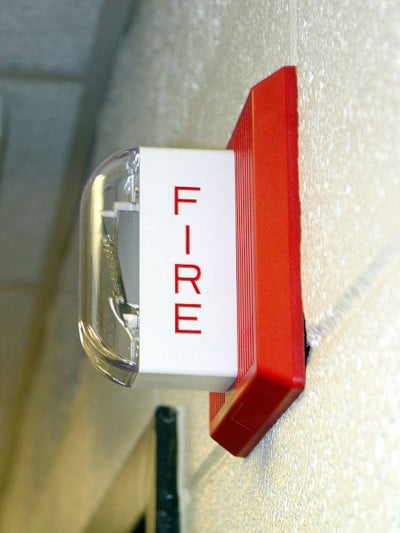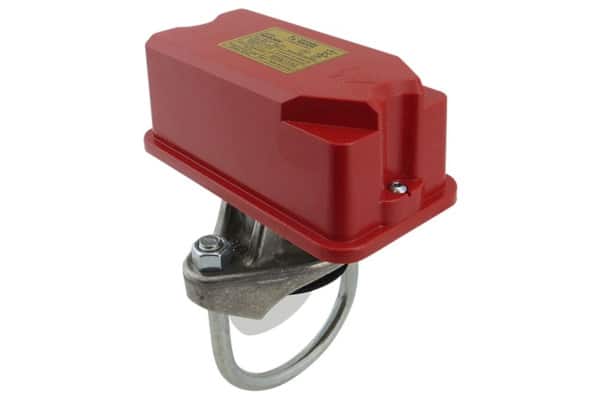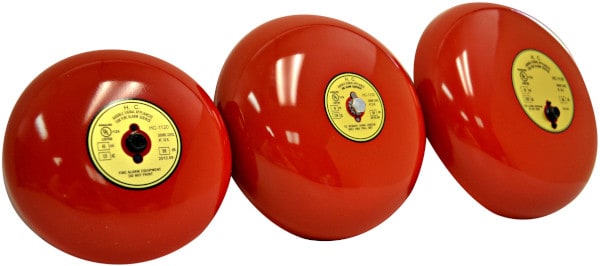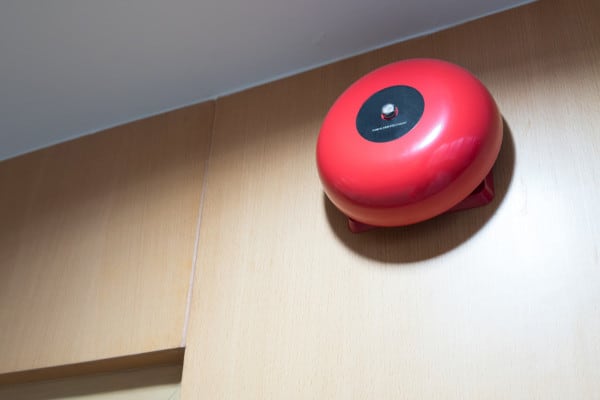Fire bells, a type of “notification appliance,” have varying placement requirements depending on the purpose they serve
Wall-mounted bells are installed with a variety of fire protection systems, including fire alarms, fire sprinklers, and standpipes. Because there are several different applications for these and other audible notification devices — applications that range from causing evacuation to getting the attention of firefighters — the proper placement of these devices varies.
In this article, we explain how today’s most commonly used fire codes specify (or don’t) fire alarm bell mounting height. We provide the most up-to-date guidance on proper bell placement for wall-mounted bells connected to fire alarm systems, as well as those connected to waterflow alarms in fire sprinkler and standpipe systems.
Ready to mount your bell? Don’t forget to protect yours in accordance with code requirements. QRFS carries:
- Air-tight fire bell back boxes made to protect indoor and outdoor bells against wear
- 12″, corrosion-resistant bell guards to defend 6″, 8″, and 10″ alarm bells against nesting birds, vandalism, and light impact
- A full line of fire bells and accessories
Notification appliances like wall-mounted bells are a required part of many fire alarm systems
The National Fire Protection Association (NFPA) and the International Code Council (ICC) develop model codes that are adopted (sometimes with modifications) by state and local governments. NFPA 101: Life Safety Code dictates, in addition to many other things, which types of buildings require fire alarm systems. So does the International Building Code (IBC), among other ICC codes (“I-Codes”). The specific requirements for each type of building are detailed across numerous chapters covering the specific needs of schools, hospitals, auditoriums, and other occupancy types.
But model codes only provide an overview of the types of devices required for a given fire alarm system. When it comes to the particulars — including the rules governing the mounting heights for fire alarm bells — fire protection professionals turn to NFPA 72: National Fire Alarm and Signaling Code. In fire alarm systems, fire alarm bells belong to a group of devices known as “notification appliances,” and, within that category, “audible notification appliances.”
From the 2022 edition of NFPA 72
3.3 General Definitions.
3.3.189 Notification Appliance. A fire alarm system component such as a bell, horn, loudspeaker, visual notification appliance, or text display that provides audible, tactile, or visual outputs, or any combination thereof. (SIG-NAS)
3.3.189.1 Audible Notification Appliance. A notification appliance that alerts by the sense of hearing. (SIG-NAS)
Chapter 18 of NFPA 72 provides specific guidelines for notification appliances, including wall-mounted bells. While these rules provide important information about the mounting and use of bells and other notification devices, building-specific conditions, manufacturing specifications, and the preferences of local authorities ultimately dictate the type, number, and placement of notification appliances.

These notification appliances vary in their design, but all aid in the effort to help a building’s occupants escape and survive a dangerous situation.
From the 2022 edition of NFPA 72
18.1* Application.
18.2 Purpose. Notification appliances shall provide stimuli for initiating emergency action and provide information to users, emergency response personnel, and occupants.
Fire alarm bells and other audible notification devices should be mounted at heights prescribed by the fire code and the manufacturer’s instructions
“Notification appliances” is a catch-all term covering devices as varied as sirens, horns, strobe lights, bells, and electric sounders. As such, while NFPA 72 does provide a height range for mounting them, all notification appliances should be mounted in accordance with any specific instructions provided by the manufacturer.
From the 2022 edition of NFPA 72
18.3.5 Mounting.
18.3.5.2 Appliances shall be mounted in accordance with the manufacturer’s published instructions.
Fire alarm bells installed as part of an NFPA 72 fire alarm system should be mounted well above the head of an average person while leaving clearance between the bell and the ceiling.
From the 2022 edition of NFPA 72
18.4 Audible Characteristics.
18.4.9 Location of Audible Notification Appliances for Building or Structure.
18.4.9.1 If ceiling heights allow, and unless otherwise permitted by 18.4.9.2 through 18.4.9.5, wall-mounted appliances shall have their tops above the finished floors at heights of not less than 90 in. (2.29 m) and below the finished ceilings at distances of not less than 6 in. (150 mm).
Most fire alarm bells should be mounted at heights that place their tops above the floor at a height of at least 90 inches, or 7 1/2 feet, leaving at least 6 inches between the ceiling and the bell.
Exceptions to standard fire alarm bell mounting heights must account for audibility in fire alarm systems
Some exceptions to the mounting heights prescribed in section 18.4.9.1 are permissible. As long as the alarm bell or other audible notification appliance can provide the needed sound pressure level and comply with other requirements throughout the standard, installers can mount the device at other heights.
From the 2022 edition of NFPA 72
18.4.9.5 Mounting heights other than required by 18.4.9.1 and 18.4.9.2 shall be permitted, provided that the sound pressure level requirements of 18.4.4 for public mode or 18.4.5 for private mode, or 18.4.6 for sleeping areas, based on the application, are met.
The rationale for these requirements is simple: the device’s position impacts how loud it will sound to nearby occupants. Audibility requirements apply to all such devices no matter how they’re installed. Thus, wall-mounted bells may be mounted at non-standard heights so long as they deliver the necessary volume in the area served by the bell.

Those required volume levels depend on where the notification device is used and what it’s used for. NFPA 72 describes separate audibility requirements for:
- Public mode signals
- Private mode signals
- Signals in sleeping areas
The difference between public and private mode signals can confuse even fire protection professionals. In short, fire alarm bells used to produce public mode signals are designed to notify everyone in a given area or building of the alarm. Private mode signals, on the other hand, are designed only to notify people responsible for taking action during an emergency.
Signals in sleeping areas are pretty self-explanatory, and they must be louder relative to the ambient sound level to make sure people wake up and take action.
From the 2016 edition of NFPA 72
18.4.4* Public Mode Audible Requirements.
18.4.4.1* To ensure that audible public mode signals are clearly heard, unless otherwise permitted by 18.4.4.2 through 18.4.4.5, they shall have a sound level at least 15 dB above the average ambient sound level or 5 dB above the maximum sound level having a duration of at least 60 seconds, whichever is greater, measured 5 ft (1.5 m) above the floor in the area required to be served by the system using the A-weighted scale (dBA).
18.4.5 Private Mode Audible Requirements.
18.4.5.1* To ensure that audible private mode signals are clearly heard, they shall have a sound level at least 10 dB above the average ambient sound level or 5 dB above the maximum sound level having a duration of at least 60 seconds, whichever is greater, measured 5 ft (1.5 m) above the floor in the area required to be served by the system using the A-weighted scale (dBA).
18.4.6 Sleeping Area Requirements.
18.4.6.1* Where audible appliances are installed to provide signals for sleeping areas, they shall have a sound level of at least 15 dB above the average ambient sound level or 5 dB above the maximum sound level having a duration of at least 60 seconds or a sound level of at least 75 dBA, whichever is greater, measured at the pillow level in the area required to be served by the system using the A-weighted scale (dBA).
Each of these requirements guarantees that the bell can be heard over expected noise levels in a given scenario. Both public and private mode signals are measured five feet above the floor while sleeping area signals are measured at the pillow level. All three signal types err on the side of loudness.
Measuring or carefully estimating sound levels is critical for those working with wall-mounted bells
Sound levels vary for different types of occupancies. In Annex A to NFPA 72, examples of average sound levels for public mode signals — in piers, businesses, schools, and other occupancy types — are provided. While these examples aren’t a substitute for the actual “average ambient sound level” in a given space, they do illustrate that these levels in one type of occupancy may be a hundred or even a thousand times greater in intensity than another, even if the loudness the listener perceives is substantially less.
These differences in audibility need to be carefully accounted for when determining fire alarm bell mounting height. Baseline sound levels in already-existing buildings can be measured with a sound-pressure-level meter, as shown in the video below:
In a building under construction, this task can be more difficult. Installers must estimate sound levels based on the acoustics of the room. But in any case, installers can’t simply rely on the fire alarm bell’s rated sound pressure. While each fire alarm bell is rated to produce a certain level of sound at a given distance, those levels drop 6 decibels with each doubling of distance. If it isn’t loud enough, adjusting the mounting height of a fire alarm bell — particularly, by bringing it closer to the five-foot mark or “pillow level” — may allow it to deliver the necessary sound pressure level.
However, these levels do have a cap: at the minimum hearing distance, the combined noise level of the notification device and any ambient sound can’t be any louder than 110 decibels.
From the 2022 edition of NFPA 72
18.4.1.2* The total sound pressure level produced by combining the ambient sound pressure level with all audible notification appliances operating shall not exceed 110 dBA at the minimum hearing distance.
Fire sprinkler and standpipe systems may feature bells with waterflow detectors, but little guidance on mounting is provided
While the requirements for bells serving fire alarm systems provide detailed, specific guidance on mounting height, bells serving fire sprinkler and standpipe systems have far fewer guidelines.
In our article on where a fire alarm bell must be placed in relation to a fire department connection (FDC), we explained that sprinkler systems having more than 20 sprinklers require waterflow alarms. When water flows through fire sprinkler system piping at a rate greater than or equal to the flow required to supply a single automatic sprinkler, these devices sound an audible alarm. These alarm units may feature a horn, siren, gong, or bell — but the point, among other things, is to let firefighters and staff know that the fire sprinkler system is active.

NFPA doesn’t specify a mounting height for alarm bells connected to waterflow alarms. In fact, few details on placement are provided at all. In a non-binding section of NFPA 13: Standard for the Installation of Sprinkler Systems, the Annex notes that alarms connected to waterflow detectors, when required, are typically located outside.
From the 2022 edition of NFPA 13
A.16.11.1.1 Audible alarms are normally located on the outside of the building. Listed electric gongs, bells, horns, or sirens inside the building, or a combination of such used inside and outside, are sometimes advisable. Outside alarms might not be necessary where the sprinkler system is used as part of a central station, auxiliary, remote station, or proprietary signaling fire alarm system, utilizing listed audible inside alarm devices.
A nearly identical provision located in section A.5.6 of NFPA 14: Standard for the Installation of Standpipe and Hose Systems suggests that the same is true for waterflow detectors serving standpipe systems.
However, slightly more detail is provided in jurisdictions adopting the International Building Code (IBC). The IBC specifies two key details regarding the mounting of fire alarm bells and other audible devices: first, the audible device should be placed outdoors, and second, it should be in a location approved by local fire officials.
From the 2018 edition of the International Building Code
[F]903.4.2 Alarms.
An approved audible device, located on the exterior of the building in an approved location, shall be connected to each automatic sprinkler system. Such sprinkler waterflow alarm devices shall be activated by water flow equivalent to the flow of a single sprinkler of the smallest orifice size installed in the system. Where a fire alarm system is installed, actuation of the automatic sprinkler system shall actuate the building fire alarm system.
If for some reason indoor placement is required, the fire alarm bell mounting height should account for the characteristics of the surrounding space. While NFPA 72’s audibility provisions aren’t applied to fire alarm bells connected to NFPA 13 or NFPA 14 waterflow alarms, they’re worth considering — if only to guarantee that the alarm can be heard.
Shop a selection of wall-mounted bells ready for installation in fire sprinkler, standpipe, and fire alarm systems
QRFS carries a selection of 6-inch, 8-inch, and 10-inch alarm bells for waterflow alarms in fire sprinkler and standpipe systems, as well as NFPA 72 fire alarm systems. Each bell features a corrosion-resistant, easy-to-see red enamel finish on a heavy steel gong. These 24-volt and 120-volt UL-listed bells are rated to produce sound levels as high as 98 decibels at a distance of 10 feet.

Available accessories for these bells include an air-tight back box designed to protect sensitive electrical components from water, weather, dust, and debris, and a fire alarm bell wire guard designed to shield bells against impact and nesting birds.
Click here to view our selection of fire alarm bells, wire guards, and back boxes.
Want to know more about the proper placement of fire alarm bells? Questions about our products? Call us at +1 (888) 361-6662 or email support@qrfs.com.
This blog was originally posted at blog.qrfs.com and updated on Dec. 31, 2022. If this article helped you determine the appropriate fire alarm bell mounting height, check us out at Facebook.com/QuickResponseFireSupply or on Twitter @QuickResponseFS.




Do you guys ever give classes on water flow ,water motor going bells…?
We don’t currently provide classes or training. But, we do have a blog on water motor gongs, Contractors’ Preference: Alarm Bells, Water Motor Gongs & Fire Alarms. We hope it is helpful!
Wery good and useful explanation! Thanks! Regards from Serbia
Thank you Valerija!
Can a horn and strobe be used in place of a standard bell on the exterior of the fire riser room?
Ryan —
Here are some relevant sections from NFPA 13 (2022 edition):
Basic requirement:
16.11.2.1 Local Waterflow Alarms.
A local waterflow alarm shall be provided on every sprinkler system having more than 20 sprinklers.
Note that if the horn/strobe is tied to a fire alarm system, additional requirements kick in:
“Subsection 16.11.2 does not mandate the activation of a building fire alarm system when the sprinkler system is activated. If this feature is desired or specifically required by a building code, details, such as electrical circuit arrangement, time for alarm annunciation, and acceptable components, on this type of alarm system are contained in NFPA 72.”
A section mentioning horns:
16.11.1.1*
An alarm unit shall include a listed mechanical alarm, horn, or siren or a listed electric gong, bell, speaker, horn, or siren.
But if anything is outdoor, note this:
16.11.1.2* Exterior water motor-operated or electrically operated bells shall be weatherproofed and guarded.
Thanks for reading. If you have specific questions about your system and its components, we advise contacting a qualified local fire protection pro!